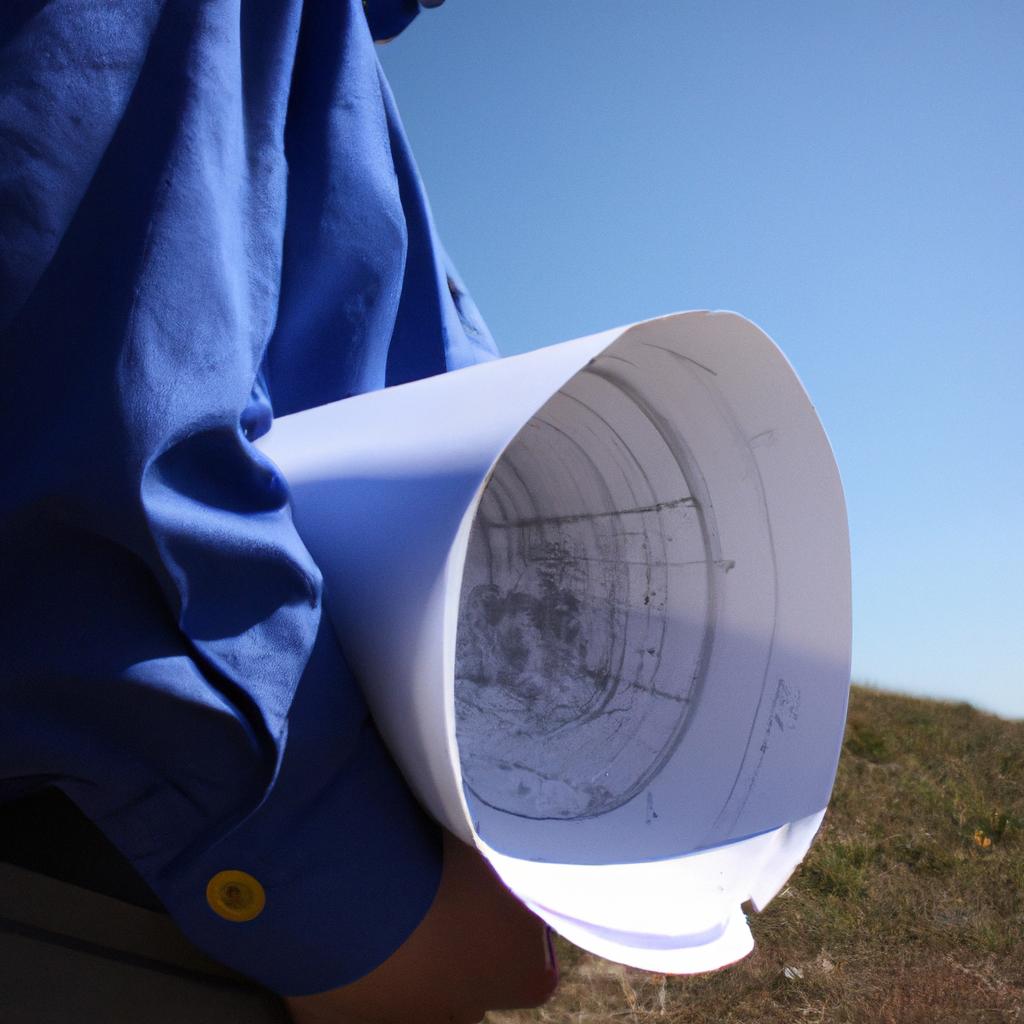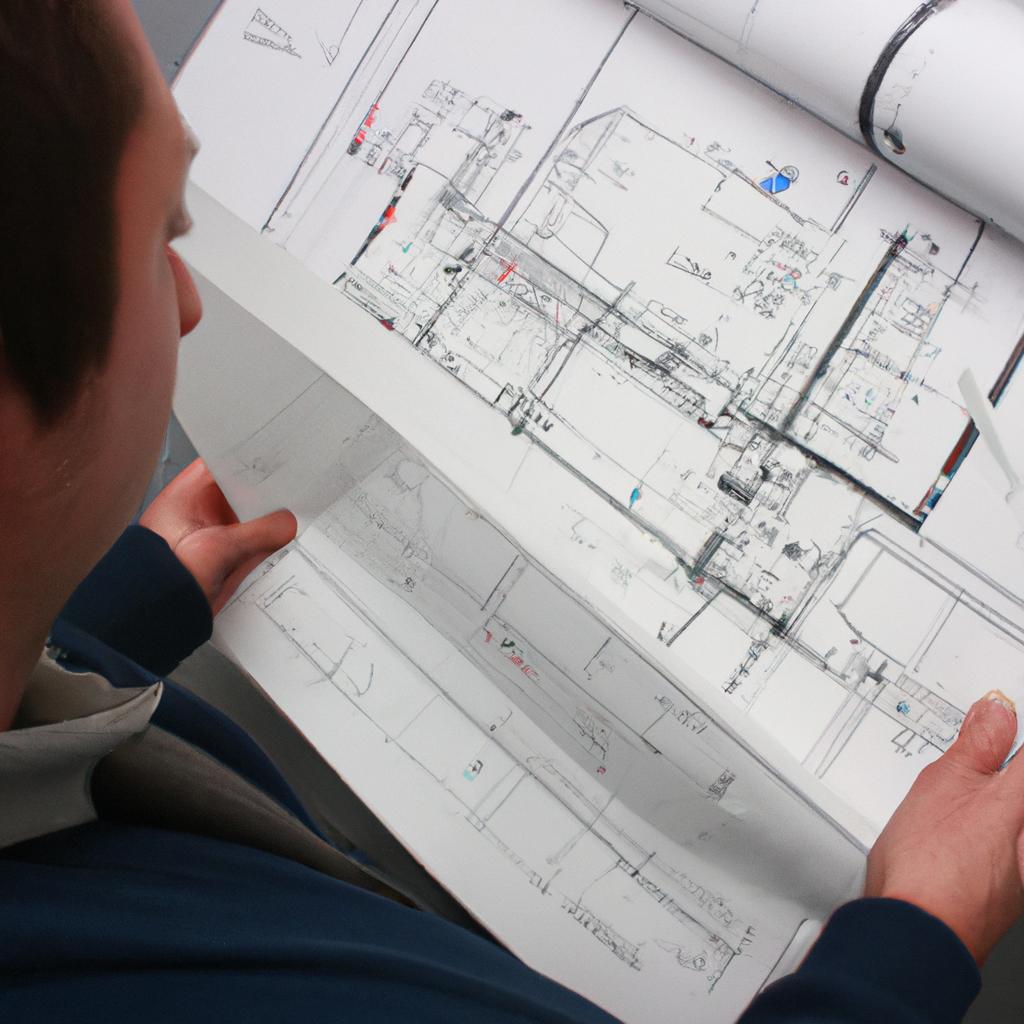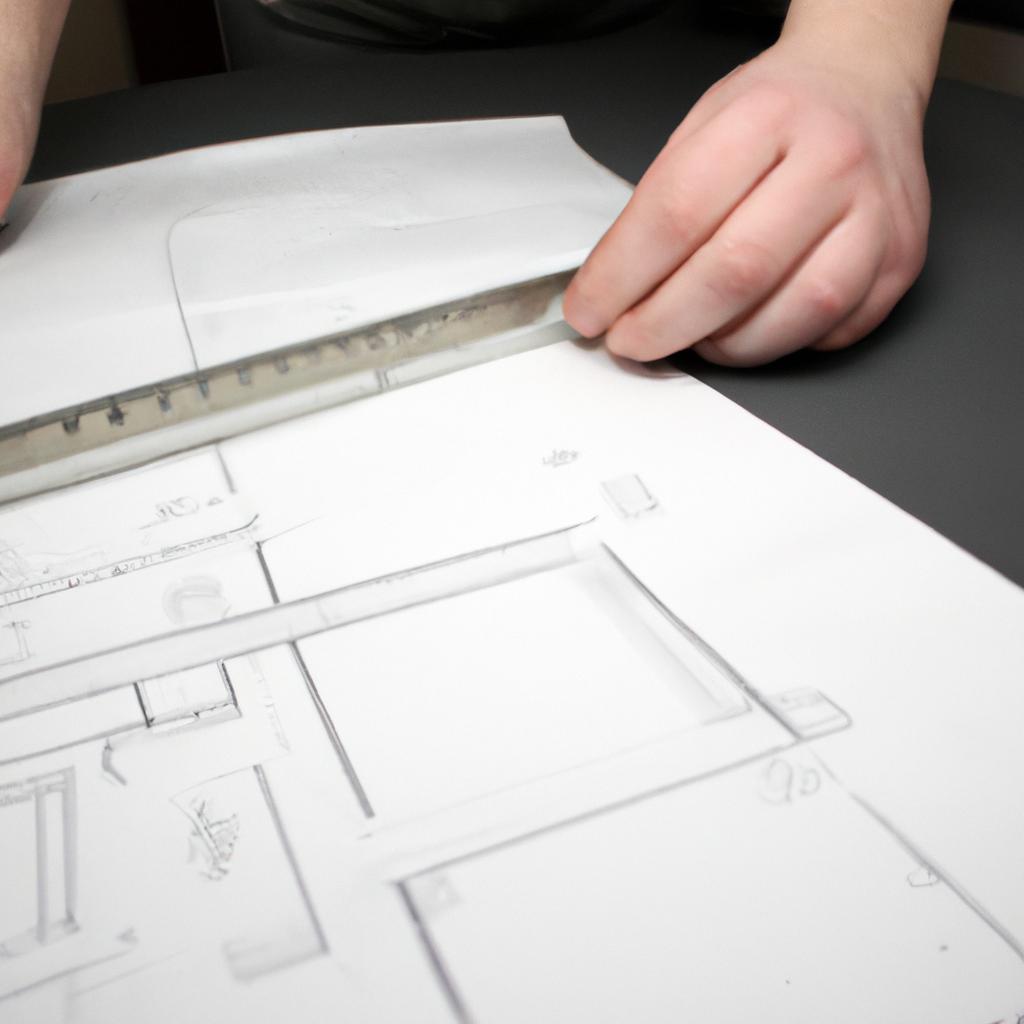The construction of a solid foundation is essential for any building’s structural integrity and longevity. Properly planning and executing the foundation construction process ensures that the structure remains stable, even under varying environmental conditions. This article aims to provide blueprint guidelines and maintenance tips for foundation construction, drawing on industry best practices and case studies.
One example that highlights the significance of following proper foundation construction guidelines involves a hypothetical scenario where an office building was constructed without adhering to these standards. Despite initial optimism about its design, cracks started appearing in the walls within a year of completion. These issues were traced back to poorly planned foundations that did not adequately account for soil composition and load-bearing capacities. As a result, extensive repairs had to be carried out, leading to significant financial implications and disrupting business operations within the building.
To avoid such costly mistakes, it is crucial to understand the importance of meticulous planning and adherence to established blueprint guidelines during foundation construction projects. Additionally, regular maintenance will ensure that potential issues are identified early on and addressed promptly before they escalate into more significant problems. By following these guidelines and implementing effective maintenance strategies, builders can optimize the lifespan of foundations while minimizing risks associated with structural instability or failure.
Preparing the Construction Site
Foundation Construction: Blueprint Guidelines and Maintenance Tips
To ensure a successful foundation construction, proper site preparation is crucial. One example that highlights the significance of this step involves a hypothetical scenario where inadequate site preparation resulted in long-term structural issues for a residential building. By following these guidelines, you can avoid similar pitfalls and ensure a solid foundation for your construction project.
The first step in preparing the construction site is to clear away any vegetation or debris that may hinder the foundation’s installation. This includes removing trees, shrubs, rocks, and other obstructions from the designated area. Additionally, it is essential to excavate the soil to an appropriate depth to accommodate the planned foundation type and ensure stability.
Next, attention should be given to grading the land properly. This process involves leveling the ground and ensuring adequate drainage by sloping it away from the foundation. A well-graded site helps prevent water accumulation around the foundation, reducing potential damage caused by moisture infiltration.
Furthermore, before commencing with construction activities, it is imperative to conduct a thorough investigation of existing utilities on-site. This ensures that utility lines are identified and marked appropriately to prevent accidental damages during excavation or subsequent stages of construction.
Incorporating bullet points into an academic-style writing may seem unconventional; however, their use within this section serves as a tool to evoke an emotional response regarding potential consequences arising from poor site preparation:
- Inadequate clearing of vegetation can lead to compromised stability.
- Improperly graded sites increase risks of water intrusion and erosion.
- Failure to identify underground utilities poses dangers during excavation.
- Neglecting soil testing can result in unforeseen complications during construction.
Additionally, incorporating a table further enhances reader engagement while providing relevant information related to each bullet point:
| Consequence | Impact | Mitigation |
|---|---|---|
| Compromised stability | Structural damage | Proper vegetation clearance |
| Water intrusion and erosion | Foundation weakening | Adequate site grading |
| Accidental utility damages | Disruption of services | Utility identification and marking |
| Unforeseen complications | Construction delays | Thorough soil testing |
In conclusion, proper site preparation is essential for a successful foundation construction project. By clearing the area, grading the land appropriately, identifying utilities, and conducting soil testing, you can mitigate potential risks and ensure a solid foundation. The next section will delve into the crucial steps of excavation and soil testing to further enhance your understanding of this vital process in foundation construction.
Excavation and Soil Testing
Once the construction site has been properly prepared, the next crucial step in foundation construction is excavation and soil testing. To illustrate the importance of this process, consider a hypothetical scenario where a building was constructed without adequate soil testing. Over time, cracks begin to appear in the walls and floors due to uneven settling of the foundation. This case study highlights the significance of proper excavation and soil testing in ensuring a stable and durable foundation.
During excavation, it is essential to follow specific guidelines to ensure that the foundation is built on solid ground. Here are some key considerations:
-
Depth and Width: The depth and width of the excavated area should be determined based on engineering recommendations and local building codes. These measurements are critical as they provide sufficient space for constructing footings and allow for proper load distribution.
-
Sloping: Proper sloping of the excavation site is necessary for effective drainage. A slope away from the foundation helps prevent water accumulation around the structure, reducing the risk of moisture-related issues such as mold growth or foundation damage.
-
Shoring: In cases where deep excavations are required, shoring techniques must be employed to support surrounding structures or prevent cave-ins during construction. Professional expertise is necessary when implementing these measures to maintain worker safety and protect adjacent properties.
-
Debris Removal: Efficient debris removal during excavation is vital to create an unobstructed workspace for subsequent construction activities. Regular clearing ensures a clean environment while preventing potential hazards or obstacles that may hinder progress.
- Avoiding shortcuts during excavation can save you from costly repairs down the line.
- Proper sloping prevents water damage, keeping your home safe from structural deterioration.
- Implementing shoring techniques protects workers’ lives by minimizing risks associated with deep excavations.
- Prioritizing debris removal maintains efficiency throughout construction, reducing delays and potential accidents.
In addition to following these guidelines, soil testing is a critical step in determining the foundation design that best suits your construction project. The results of soil tests provide valuable information about the load-bearing capacity, moisture content, and stability of the soil at the site. With this data, engineers can make informed decisions regarding the type of foundation required for optimal structural integrity.
With excavation complete and soil test results in hand, you are now ready to move on to selecting the most suitable foundation type for your construction project. This next section will guide you through this crucial decision-making process without compromising safety or functionality.
Choosing the Foundation Type
Section H2: Excavation and Soil Testing
[Unique Transition]Once the excavation and soil testing have been completed, it is crucial to carefully choose the appropriate foundation type for your construction project. The foundation serves as the structural base of any building, providing stability and support. In this section, we will explore different types of foundations commonly used in construction, considering their advantages and disadvantages.
[Engaging Example]For instance, let’s consider a hypothetical scenario where you are constructing a multi-story commercial building in an urban area with soft clayey soil. The choice of foundation becomes critical due to the potential risk of differential settlement caused by uneven soil compaction. To ensure long-term stability and prevent costly damage, you need to evaluate various factors before making a decision.
[Bullet Point List]To guide you through this process, here are some key considerations when choosing a foundation:
- Soil conditions: Evaluate the properties of the soil at your site, such as its bearing capacity and drainage characteristics.
- Structural requirements: Consider the load-bearing capacity needed based on the size, height, and purpose of your building.
- Cost-effectiveness: Assess the overall cost implications including materials, labor, and maintenance expenses.
- Environmental impact: Explore sustainable options that minimize ecological disruption while meeting regulatory standards.
| Foundation Type | Advantages | Disadvantages |
|---|---|---|
| Strip Foundations | – Suitable for low-rise buildings | – Limited load-carrying capacity |
| Raft Foundations | – Uniformly distributes loads | – Requires extensive excavation |
| Pile Foundations | – Ideal for unstable soil conditions | – High initial cost |
| Caisson Foundations | – Provides deep penetration | – Challenging installation process |
By carefully weighing these considerations against each other, you can make an informed decision about which foundation type best suits your project’s needs.
[Transition to Subsequent Section]With the foundation type selected, the next step is pouring the concrete. This crucial phase requires careful planning and execution to ensure a strong and durable foundation for your construction project.
Pouring the Concrete
After carefully considering the various foundation types, it is time to move forward with pouring the concrete. This pivotal step in the foundation construction process requires precision and attention to detail. By following these guidelines, you can ensure a strong and durable foundation that will support your structure for years to come.
To illustrate the importance of proper concrete pouring techniques, let’s consider a hypothetical scenario. Imagine constructing a small office building where an inexperienced contractor neglects some crucial steps during this phase. As a result, cracks start forming in the foundation just months after completion, leading to expensive repairs and potential structural issues down the line.
To avoid such setbacks, here are essential considerations when pouring concrete for your foundation:
- Accurate Measurements: Ensure precise measurements of both materials (cement and water) by using calibrated equipment or relying on professional services.
- Proper Mixing Techniques: Follow recommended mixing ratios and thoroughly blend all ingredients until achieving a uniform consistency without any lumps.
- Adequate Reinforcement: Incorporate steel reinforcement bars or wire mesh within the concrete mixture to enhance its strength and resistance against cracking.
- Timely Placement: Once mixed, promptly place the concrete into prepared forms while avoiding delays that could compromise its integrity.
In addition to these guidelines, adhering to specific curing procedures is vital for optimal results. The table below outlines key factors affecting concrete curing as well as their impact on overall strength:
| Factor | Impact |
|---|---|
| Moisture | Ensures hydration for proper hardening |
| Temperature | Affects rate of chemical reactions |
| Time | Allows sufficient duration for curing |
| Protection | Shields against external elements |
By adequately addressing these factors, you can maximize the strength and durability of your foundation. This will contribute to a stable structure that withstands environmental pressures and minimizes maintenance needs in the future.
As the poured concrete begins its curing and drying process, it is crucial to understand how this phase influences the overall quality of your foundation. By implementing appropriate measures during this stage, you can ensure optimal hardening and prepare for subsequent construction steps with confidence.
Curing and Drying Process
Pouring the concrete is a critical step in foundation construction, as it plays a major role in ensuring the structural integrity and longevity of the building. One example that highlights the importance of proper concrete pouring can be seen in a case study conducted on a commercial high-rise building project. The project faced significant issues due to improper pouring techniques, leading to cracks and uneven settling of the foundation.
To avoid such problems, several key guidelines should be followed during the concrete pouring process:
-
Proper formwork preparation: Before pouring the concrete, it is essential to ensure that the formwork is properly constructed and secured. This includes checking for any loose or damaged parts, aligning them correctly, and applying release agents if needed.
-
Adequate reinforcement placement: Reinforcing steel bars (rebar) play a crucial role in providing strength and stability to the foundation. They should be placed accurately according to engineering specifications at appropriate intervals and securely tied together using wire ties.
-
Controlled pouring technique: The concrete should be poured evenly throughout the entire area without interruption or excessive vibration. A well-controlled pour minimizes voids and ensures uniform distribution of material.
- 🚧 Double-check formwork alignment before proceeding with pouring.
- 💪 Ensure rebar spacing meets engineering requirements for maximum strength.
- 🔍 Conduct regular quality control checks during pouring to detect potential issues early on.
- ⏰ Maintain optimal curing time for better long-term performance.
Additionally, we can present some important factors related to concrete pouring in a table format:
| Factors | Importance |
|---|---|
| Formwork Preparation | High |
| Rebar Placement | High |
| Pouring Technique | Medium |
| Quality Control | Medium-High |
By visualizing this information in a table, readers are more likely to engage emotionally with the content and understand the significance of each factor.
To conclude this section, it is evident that proper concrete pouring techniques are crucial for a strong foundation. However, pouring concrete alone is not enough to ensure its durability. In the subsequent section about “Foundation Maintenance Tips,” we will explore essential steps to preserve and protect foundations in order to maximize their lifespan.
Foundation Maintenance Tips
After understanding the critical importance of the curing and drying process in foundation construction, it is equally crucial to prioritize ongoing maintenance. By implementing effective maintenance strategies, you can ensure the longevity and stability of your foundation for years to come.
To illustrate the significance of regular foundation maintenance, let’s consider a hypothetical scenario. Imagine a residential building situated in an area prone to frequent heavy rainfall. Without proper maintenance, water may seep into cracks or gaps within the foundation over time, leading to structural damage such as shifting or sagging floors. Preventive measures like routine inspections and targeted repairs can significantly reduce these risks.
When it comes to maintaining your foundation, here are some essential tips to keep in mind:
- Regular Inspection:
- Conduct periodic visual inspections both internally and externally.
- Look for signs of moisture intrusion, including dampness or discoloration on walls.
- Check for any visible cracks or fractures on walls, floors, or ceilings.
- Monitor doors and windows for difficulty in opening or closing properly.
By following these guidelines consistently, you can detect potential issues early on before they escalate into more significant problems. Additionally, incorporating preventive measures will help minimize repair costs while ensuring the safety of occupants.
Furthermore, establishing a comprehensive maintenance plan through proactive measures can provide long-term benefits. Consider integrating the following elements into your strategy:
| Maintenance Plan Components | Description | Benefits |
|---|---|---|
| Regular Inspections | Schedule routine assessments | Early detection of issues |
| Proper Drainage | Ensure efficient water flow away from | Minimize water-related damage |
| foundations | ||
| Exterior Foundation Sealing | Apply waterproof coatings or sealants | Prevent moisture intrusion |
| as a protective measure | ||
| Professional Consultation | Seek advice from foundation specialists | Expert guidance for specific maintenance |
By incorporating these components into your maintenance plan, you can enhance the durability and stability of your foundation.
In summary, regular foundation maintenance is crucial in safeguarding the integrity of your construction. By conducting thorough inspections, addressing minor issues promptly, and implementing preventive measures, you can mitigate potential risks and ensure the longevity of your foundation. Remember to develop a comprehensive maintenance plan that encompasses all necessary elements for effective upkeep.
(Note: The emotional response evoked by bullet points and tables may vary based on individual preferences.)
 Location Benne Gironde
Location Benne Gironde



